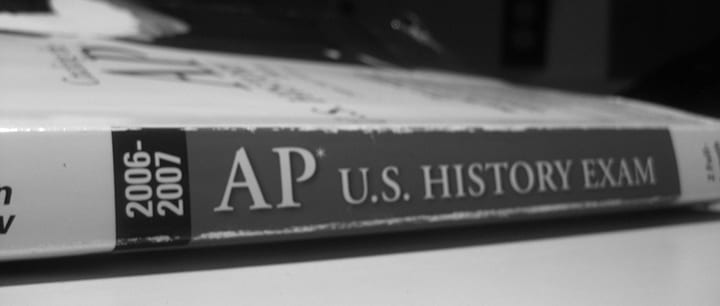 Getting ready to take the AP World History Exam? Brush up on these study tips from Olympia, WA tutor Tali H…
Getting ready to take the AP World History Exam? Brush up on these study tips from Olympia, WA tutor Tali H…
Lucky for you, the AP World History Exam tends to be one of the easier AP tests. It’s just over three hours long with two sections that are weighted equally: a 55-minute 70-question-multiple-choice section and a 130-minute free-response section. (Learn more about the test here.) Regardless of your intellectual capabilities, it is impossible to know every bit of history. Instead, you need to know what information to focus on.
1. Buy an AP Review Book
Instead of slogging through textbooks, which generally overload the reader with information, facts, and dates, buy an AP review book, which highlights the important concepts in compact units. I recommend Cracking the AP World History Exam (used, slightly dated editions like the 2012 version can be found on Amazon.com for under $1). These books are also loaded with test questions and come with two full-length practice tests.
2. Know the World Map
In order to get a solid grasp on the material you’re learning, you should first become familiar with the world map. Pay special attention to places that have changed over time. For example, “Mexico” used to be called “New Spain” and “East Pakistan” is now “Bangladesh.” I’ve seen plenty of students confused because, not realizing the territory has been renamed, they can’t find New Spain on the map! To make sure you have a good geographical foundation, practice drawing the world map a few times (or at least filling in a pre-drawn but blank world map). Make it a contest with fellow classmates or friends to spice up this activity. Also, there are plenty of online sites to test your “map and geography knowledge.” (Try Lizard Point Geography Quizzes.)
3. Make A Timeline
Many teachers will tell you “dates aren’t that important for the exam.” In essence, I agree with this statement, especially the farther back in history you go. However, it’s important to know the general chronology of historical events. Here’s why: The AP World History Exam places emphasis on global interactions and change-over-time (there is actually a “Change-Over-Time” essay), both of which require having a reasonable idea of when things occur (not necessarily dates) and what else is going on in the world simultaneously. This emphasis makes sense: People, countries, and continents are not isolated. They may exist separately but they fluctuate together, constantly evolving. So, to really understand “time,” I suggest a timeline. Now, because so much happens in our world’s history, it’s important to have a big timeline. If there’s room in your house, put up a roll of paper from one of the wall to the other. Then you can make a line and label events as you go through the world history course. Make it interactive by drawing pictures to go with significant events. If you don’t have room in your house, you can go online. I recommend Prezi.com (or a similar site with a wide open canvas that you can zoom around on, add information, and upload pictures and video).
4. Supplement Your Reading
If you’re taking a class, you will almost undoubtedly be working with a history textbook. However, words on a page often have trouble sticking in our brains by themselves. What you need to do is find movies and short videos (use Youtube) that you can watch after you’ve read about an event. Then go back to the textual information and reread it, checking to see if the way you imagined the event matched up with what you saw. This helps you more than you realize. By combining reading and watching, you’re first creating an original virtual reality experience, then comparing that with the media you’re viewing, and then, during the second read through, you’re analyzing the differences. This process interweaves many facets of your brain enabling strong recall and memory with the information you’re learning.
Yes, it may take a little extra time to read, watch, and then reread information on one particular concept. You definitely don’t want to do this with every significant event. To start, I recommend choosing 10 important events (spaced out over our historical timeline) that interest you.
How do you choose the events? If you have an AP Review Book, they will have an “important events” list at the end of each unit, which are generally separated by time periods. Otherwise, go online, type in “AP World History Important Dates,” and choose some from a list that comes up.
If you’re stuck, here’s a good starter list (but remember there are so many to choose from):
- 2000 Judaism begins w/Abraham
Don’t forget to put all the events you spend extra time with onto your timeline.
Finally, remember that world history is just one, long, ongoing story about the human race. Try to put yourself in the shoes of those you read about and recognize that understanding the concepts is far more important than knowing exact dates. Learning specific study skills for this type of memorization can be easily achieved with a tutor, so check out TakeLesson’s selection of experienced world history tutors for additional help. For more information about the test, visit The College Board’s website.
 Tali H. tutors in various academic subjects in Olympia, WA, as well as through online lessons. Since 2010, she has worked with numerous students in elementary, middle, high school, and college in both group settings and one-on-one. Learn more about Tali here!
Tali H. tutors in various academic subjects in Olympia, WA, as well as through online lessons. Since 2010, she has worked with numerous students in elementary, middle, high school, and college in both group settings and one-on-one. Learn more about Tali here!
 Photo by KarandeepSingh
Photo by KarandeepSingh
Suzy S.
